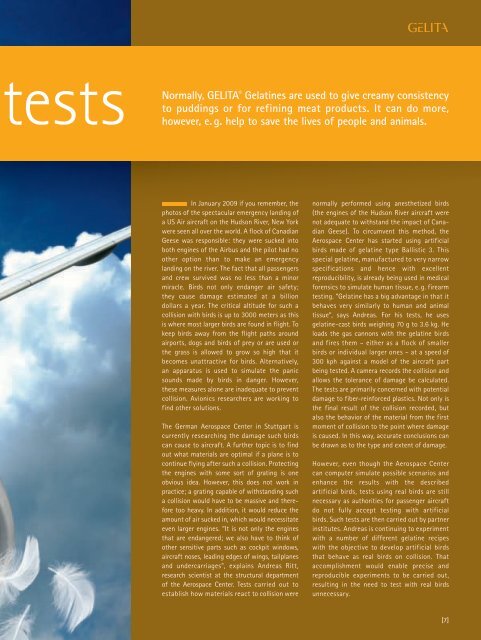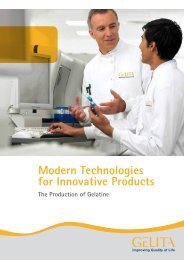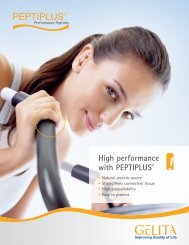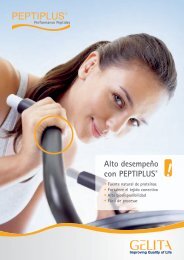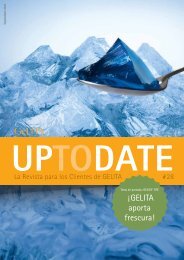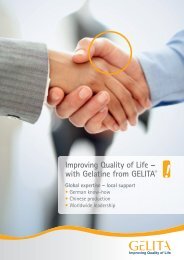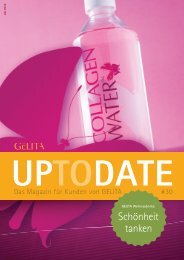Create successful ePaper yourself
Turn your PDF publications into a flip-book with our unique Google optimized e-Paper software.
tests<br />
Normally, GELITA ® Gelatines are used to give creamy consistency<br />
to puddings or for refining meat products. It can do more,<br />
however, e. g. help to save the lives of people and animals.<br />
In January 2009 if you remember, the<br />
photos of the spectacular emergency landing of<br />
a US Air aircraft on the Hudson River, New York<br />
were seen all over the world. A flock of Canadian<br />
Geese was responsible: they were sucked into<br />
both engines of the Airbus and the pilot had no<br />
other option than to make an emergency<br />
landing on the river. The fact that all passengers<br />
and crew survived was no less than a minor<br />
miracle. Birds not only endanger air safety;<br />
they cause damage estimated at a billion<br />
dollars a year. The critical altitude for such a<br />
collision with birds is up to 3000 meters as this<br />
is where most larger birds are found in flight. To<br />
keep birds away from the flight paths around<br />
airports, dogs and birds of prey or are used or<br />
the grass is allowed to grow so high that it<br />
becomes unattractive for birds. Alternatively,<br />
an apparatus is used to simulate the panic<br />
sounds made by birds in danger. However,<br />
these measures alone are inadequate to prevent<br />
collision. Avionics researchers are working to<br />
find other solutions.<br />
The German Aerospace Center in Stuttgart is<br />
currently researching the damage such birds<br />
can cause to aircraft. A further topic is to find<br />
out what materials are optimal if a plane is to<br />
continue flying after such a collision. Protecting<br />
the engines with some sort of grating is one<br />
obvious idea. However, this does not work in<br />
practice; a grating capable of withstanding such<br />
a collision would have to be massive and therefore<br />
too heavy. In addition, it would reduce the<br />
amount of air sucked in, which would necessitate<br />
even larger engines. “It is not only the engines<br />
that are endangered; we also have to think of<br />
other sensitive parts such as cockpit windows,<br />
aircraft noses, leading edges of wings, tailplanes<br />
and undercarriages”, explains Andreas Ritt,<br />
research scientist at the structural department<br />
of the Aerospace Center. Tests carried out to<br />
establish how materials react to collision were<br />
normally performed using anesthetized birds<br />
(the engines of the Hudson River aircraft were<br />
not adequate to withstand the impact of Canadian<br />
Geese). To circumvent this method, the<br />
Aerospace Center has started using artificial<br />
birds made of gelatine type Ballistic 3. This<br />
special gelatine, manufactured to very narrow<br />
specifications and hence with excellent<br />
reproducibility, is already being used in medical<br />
forensics to simulate human tissue, e. g. firearm<br />
testing. “Gelatine has a big advantage in that it<br />
behaves very similarly to human and animal<br />
tissue“, says Andreas. For his tests, he uses<br />
gelatinecast birds weighing 70 g to 3.6 kg. He<br />
loads the gas cannons with the gelatine birds<br />
and fires them – either as a flock of smaller<br />
birds or individual larger ones – at a speed of<br />
300 kph against a model of the aircraft part<br />
being tested. A camera records the collision and<br />
allows the tolerance of damage be calculated.<br />
The tests are primarily concerned with potential<br />
damage to fiberreinforced plastics. Not only is<br />
the final result of the collision recorded, but<br />
also the behavior of the material from the first<br />
moment of collision to the point where damage<br />
is caused. In this way, accurate conclusions can<br />
be drawn as to the type and extent of damage.<br />
However, even though the Aerospace Center<br />
can computer simulate possible scenarios and<br />
enhance the results with the described<br />
artificial birds, tests using real birds are still<br />
necessary as authorities for passenger aircraft<br />
do not fully accept testing with artificial<br />
birds. Such tests are then carried out by partner<br />
institutes. Andreas is continuing to experiment<br />
with a number of different gelatine recipes<br />
with the objective to develop artificial birds<br />
that behave as real birds on collision. That<br />
accomplishment would enable precise and<br />
reproducible experiments to be carried out,<br />
resulting in the need to test with real birds<br />
unnecessary.<br />
[7]


